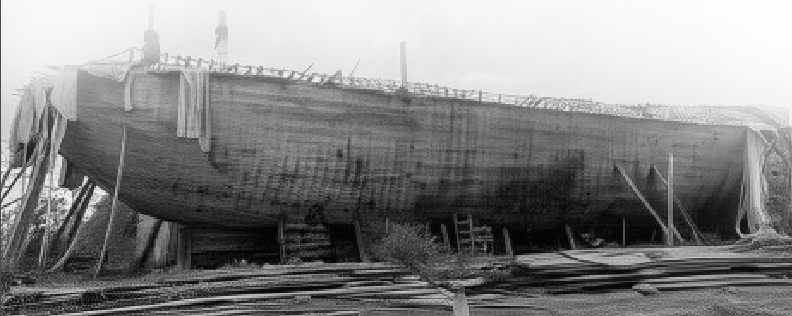Ruins of a Maritime Legacy
The report chronicles a field visit to Azhikkal Ferry’s shipbuilding industry, revealing a vivid contrast between past and present. From the abandoned, damaged vessel of the former Sulkha Shipyard to the ambitious projects of Binafa Enterprises, including ships for the Qatari royal family, the report captures themes of industrial transformation, financial challenges, and the enduring spirit of maritime heritage.
Uncovering the intricacies of the Azhikkal Ferry region’s modern industrial landscape and its deep ties to the past was the goal of my most recent field research there, an area rich in maritime history. My investigation’s main focus was the local shipbuilding industry, which finally brought me to the location of what was once the Sulkha Shipyard.
A brief moment of disorientation passed as soon as they got off the bus. Sensing my need, a wise Bengali woman asked, “Beta, kidhar jana hai tumko?” I answered simply, “Nani, mujhe shipyard jana hai,” a beat late and still taking in my surroundings. Her prompt and helpful advice took me down a narrow road, where the conspicuous “SULKHA SHIPYARD” signboard soon verified my arrival. What came next was a fascinating examination of the region’s changing industrial story, which was replete with tales of resiliency and change.
Remarks at the Shipyard: Two Stories
The enormity of the operations, which resembled a grand maritime epic, briefly overpowered my senses as I entered the premises. Two enormous ships in varying stages of construction stood in front of me; they were still skeletal but unquestionably magnificent. This initial feeling of wonder quickly gave way to a more thorough analysis of the yard’s various elements, each of which contributed to the ongoing story of the shipyard.
The man in charge kindly offered to give me a tour after I explained my affiliation and purpose, and he took me inside one of the massive ships. The interior was a separate universe. Wide corridors, elaborate underground rooms, and finely carved doors suggested the luxury and functionality expected of these future sea giants. Huge areas set aside for leisure, entertainment, and relaxation conveyed a wealth of information about their intended purpose and the opulent experiences they were intended to provide. A cool wind blowing through the open windows made it possible for me to stop and take in the wonder of human ingenuity, which is evidence of the careful preparation and expert craftsmanship required for such undertakings.
But in the middle of all this activity, a huge, partially constructed ship that appeared to be abandoned and had no apparent purpose stood out. As we approached, it was painfully evident how badly damaged it was one side was totally shattered, a glaring example of how abandoned it was. It was extremely depressing to see such a building, which was surely worth crores and lakhs, in such terrible condition, a clear indication of a sudden halt in development.
Key Findings and Historical Context
Motivated by a desire to learn more, I said to the man in charge, “Bro, let’s get right to the point?” He nodded, ready to explain the complicated history of the shipyard.
He disclosed that the partially damaged ship I saw in 2013 had been built by the original owner, whose name was displayed on the “SULKHA SHIPYARD” signboard at the entrance. Sadly, after the owner’s death, the yard shut down for a long five years. A sobering reminder of how unanticipated events can affect industrial projects, this extended closure caused the ship to sustain severe cracks, scratches, and even animal incursion damage, making it completely unusable and eventually abandoned.
He went on to describe the yard’s current organisational setup: The yard was formally rebranded from Sulkha Shipyard to Binafa Enterprises following its acquisition in 2017. Notably, Binafa Enterprises was awarded a significant contract by Qatar to build two ships, one of which will be for the royal family of Qatar. Construction on these new vessels started in 2017 and is expected to be finished by 2026. The fact that the initial value of one of these ships was estimated to be around ₹20 crore in 2017 is truly astounding. The substantial investment and economic impact of these projects are highlighted by their potentially astounding value increase by the time of completion in 2026, taking inflation and material costs into account. This revitalization has not only injected new capital but also created numerous employment opportunities for skilled local laborers, contributing significantly to the regional economy. The ripple effect extends to ancillary businesses, demonstrating the far-reaching positive impact of such industrial continuity. This transformation also underscores the global nature of modern shipbuilding, requiring complex logistical chains and highly specialized engineering expertise. The shipyard’s success now hinges on its ability to navigate international markets and adapt to evolving technological demands, ensuring its competitive edge. The community of Azhikkal Ferry, deeply intertwined with its maritime past, takes immense pride in this ongoing revival. The challenges of securing high-value international contracts and managing the intricate process of modern shipbuilding are immense, demanding precision and adherence to global standards. Yet, the dedicated workforce, many of whom come from generations of shipbuilders, demonstrates an unwavering commitment to their craft. This blend of traditional skills and contemporary technology positions Azhikkal Ferry as a significant player, not just in Kerala, but within the broader South Asian maritime industry, a testament to its enduring legacy.
Final Thoughts and Conversation
This thorough tour of Azhikkal Ferry’s shipbuilding facility gave us important new perspectives on how industrial heritage is always changing. The transition from Sulkha Shipyard to Binafa Enterprises is a powerful illustration of how new businesses can arise from pre-existing locations, usually bringing with them new funding and a dynamic change in the scope and goals of operations. The sharp contrast between the half-built, abandoned ship and the ambitious new projects for international clients aptly captures themes of continuity, the harsh realities of financial obstacles, and the enormous potential for revitalisation within the region’s crucial maritime industry. The development of the shipyard demonstrates its function as a vibrant and active part of Azhikkal Ferry’s larger industrial and maritime heritage, showcasing its exceptional capacity to adjust to modern needs while unwaveringly upholding its historical foundation.
The echoing call to Jumua prayer (azan) suddenly interrupted my thoughts. I immediately expressed my profound gratitude to the man in charge for his invaluable time and wise counsel, which had shed a great deal of light, before heading out to find the closest mosque. As I was leaving, the sound of the ships honking seemed to reverberate in my ears, a strong and enduring reminder of the significant work that was being done at Binafa Enterprises, a representation of continuous maritime activity in a historically significant area. The experience left me with a profound appreciation for the human spirit’s ability to rebuild and innovate, even in the face of daunting challenges. Azhikkal Ferry’s shipyard is more than just a place of industry; it is a living chronicle of aspiration, setback, and eventual triumph, continuously shaping the future of maritime trade from its storied shores.

